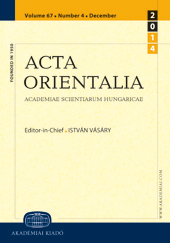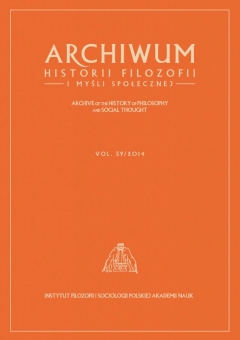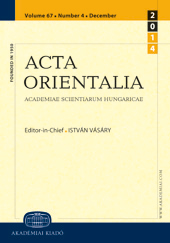Author(s): Pál Fodor / Language(s): English
Issue: 1/2007
This short survey intends to be a certain kind of introduction to the studies published in this issue of Acta Orientalia . It was the present author who, in the late 1990s, raised the idea to publish a book which would tackle the problems of Hungarian trade in the age of Ottoman conquest (16th–17th centuries) in a comprehensive way. He asked the most renowned Hungarian specialists of the field to dwell on various aspects of the topic. Unfortunately, the project could not be accomplished in its entirety for a variety of reasons. Some colleagues, owing to pressure of other engagements, could not complete their studies, while others, like Ferenc Szakály, suddenly passed away. Particularly his death proved to be fatal, because it was him who undertook to write the most comprehensive contribution to our would-be book on trade and traders in Ottoman and Habsburg Hungary (including to a certain extent Transylvania too). Finally, those who prepared their studies decided to publish the collected material, benefiting from the kind offer by the editor-in-chief of Acta Orientalia . The texts were edited by the present author who in this article tried to outline what should have been written by Szakály in greater detail. He focuses on the fate of the Hungarian traders and, in line with Szakály’s results, he concludes that, while the 16th century, owing to the rapidly expanding transit trade, saw the emergence of a peasant-burgher middle class, the worsening circumstances in the following century led to its eventual fall. The causes of this fall are highlighted in much greater detail in the studies by Zsigmond Pál Pach (who also died in the meantime) and Lajos Gecsényi. From their contributions it becomes evident that in the long run the Ottoman conquest dealt a tremendous blow not only to the political, but also to the economic life of Hungary, inasmuch as the shifting of the international trade routes, the rise of rival commercial groups and the disadvantageous imperial policies gradually crowded out the Hungarians from their previous positions. The thorough study by Antal Molnár, dedicated to the activities in Hungary of two of these rival groups, the Ragusans and the Bosnian Franciscans, emphasises the interdependence between commercial and religious life of the Christians living in Ottoman Hungary and the Northern Balkans as well as the vital role the merchants played in shaping their “national”-religious communities. János Buza explores an important but neglected aspect of monetary history: how the great powers’ struggle for supremacy in Central Europe reflected itself in monetary politics. He points out that the Habsburg, Ottoman and Venetian governments supported the primacy of their respective currencies by setting their rates of exchange higher than those of their rivals.The above-mentioned project has been implemented by the generous support of OTKA, the biggest scientific research foundation of Hungary (No. T. 018025).
More...



